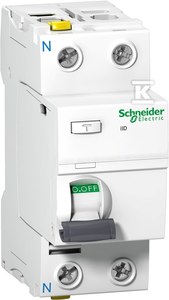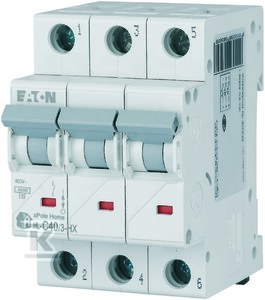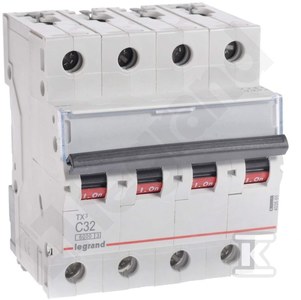A residual current device , or RCD ( Residual Current protective Device ), commonly known as a differential switch (or referred to as a differential switch), is a safety device that protects against electric shock - both in the event of direct and indirect contact. Limits the effects of damage to receivers connected to the installation. It is used as an additional protection next to the automatic power supply shutdown operating in the event of a direct phase-to-casing short circuit. Thanks to it, in the event of a short circuit in electrical installations, there is less chance of damage to equipment or electric shock.

How is the differential constructed and what are its types?
The elements that make up an RCD are:
- contacts of current circuits , together with a lock and a lever that switches on the device,
- residual current release , most often it is a polarized relay,
- circuit breaker testing circuit , which allows you to check it during use,
- Ferranti transformer – a ferromagnetic ring through which the phase wires and the neutral wire pass.
The last element is crucial, it is responsible for measuring the leakage current. A residual current device works by turning off an electrical circuit, e.g. a lighting one, if the geometric sum of the currents flowing into and out of it is not equal to zero. A residual current (leakage) then appears.
Check out the differentials in the Onninen offer
There are several ways to divide differentials. The first concerns the operating current (sensitivity) - residual current circuit breakers differ from each other in the residual current supported:
- up to 30 mA – highly sensitive devices, used where the risk of electric shock and damage to the installation is high, e.g. in bathrooms, kitchens, workshops or greenhouses,
- 30–500 mA – medium sensitivity circuit breakers installed in residential buildings, offices and construction sites,
- above 500 mA – low-sensitivity switches, used in circuits with high leakage current, and also as the main switch of the electrical installation.
RCDs are additionally distinguished by the detection of residual current : AC type - sinusoidal alternating current, A - sinusoidal alternating current, half-rectified and pulsed sinusoidal current, B - same as A and additionally direct current. The next two categories are RCCB - without built-in overcurrent protection and RCBO with such protection.
Highly sensitive switches (up to 30 mA) are most often used and are activated at a residual current of 20 mA. Lower intensity is relatively safe - a person electrocuted by electricity is able to break away from the damaged installation.
Standards and regulations regarding residual current circuit breakers
Regulation of the Minister of Infrastructure of April 12, 2002 on the technical conditions to be met by buildings and their location requires the use of RCD in paragraph 183 section 1, which stipulates that residual current protective devices should be used as a supplement to basic protection against electric shock and fire. Subsequent regulations bring standards. PN-IEC 60364-5-53:1999 states that an RCD without a protective conductor is not an effective means of protection against indirect contact. The PN-HD 60364-4-41: 2009 standard imposes the obligation to install highly sensitive differentials in plug sockets with a rated current of up to 20 A and in outdoor mobile devices (up to 32 A). An important addition is the provision in PN-HD 60364-4-41:2017-09 requiring the use of differentials in lighting circuits in households. The earlier one, PN-HD 60364-4-41:2009, was limited to bathroom lighting.
RCDs should also be installed in temporary lighting installations , such as fairs, circuses, outdoor events (PN-HD 60364-7-740:2009), exhibitions with lighting fixtures (PN-HD 60364-5-559:2010) and bathing rooms. (PN-HD 60364-7-701:2010)
Polish Standards, unless they are referred to in an act or regulation, are not mandatory. However, installers should follow them because they protect them in the event of a dispute or accident related to the electrical installation . This is confirmed by the Construction Law, which states that persons performing independent technical functions in construction are responsible for their performance in accordance with the regulations and principles of technical knowledge, and are also responsible for ensuring work diligence, organization, safety and quality.
Household and company owners are not always aware of how important it is to ensure high-quality residual current circuit breakers. It is worth making customers aware that their installation can protect against serious problems - not only discomfort, but also electric shock or equipment damage.
The lighting circuit is one of the elements of the home electrical network. Others include, for example, a circuit of plug sockets and a circuit intended for devices with a power of 2 kW and more. The need to use differentials is not the only result of the standards. In home installations, these are important devices that protect household members against electric shock due to direct and indirect touch. In addition, they limit the effects of damage to devices, including the risk of fire in the event of a failure affecting the electrical installation.
It is also important to use highly sensitive residual current circuit breakers. The maximum response current of 30 mA is due to the fact that higher values may result in paralysis of the respiratory tract in the event of shock. The devices are able to operate above 15 mA. They will not normally respond below this threshold for the sake of ensuring power reliability. The power supply may then be interrupted due to natural leakages in the installation. However, in special situations, RCDs with a residual current of up to 10 mA are used.
Circuit breakers are used primarily in TN-S and TN-CS network systems. The first one is a grounded system with separated protective and neutral conductors (PE and N). This solution is most often used in houses and apartments. TN-CS is grounded, normally non-conductive parts are connected to the neutral point of the transformer, partly has a PEN conductor, further divided into PE and N.
Check out the differentials in the Onninen offer
When not to use residual current circuit breakers
Differentials are not used in TN-C systems found in old buildings . This is prohibited by the PN-IEC 60354-5-53:1999 standard, which states that it cannot be considered an effective means of protection against indirect contact, even if the rated differential operating current does not exceed 30 mA. In this system, the PEN conductor is simultaneously the working and protective conductor, and the RCD disconnects the phase and neutral conductors at the same time, therefore also the protective conductor. It will also not work when voltage appears on the lamp housing - for the transformer there will be no difference between the incoming and outgoing current and it will not work. In turn, if the housing is not well insulated from the ground, it may disconnect the circuit due to small current leakage through it to the grounded components. According to current regulations, TN-C installations in houses and private apartments must be replaced with TN-S or TN-CS.
Differential switches are also not installed in emergency lighting circuits due to the need for their continuous operation . Such systems are out of reach and are operated by specialists with SEP qualification certificates.
You will find an attractive offer of RCD devices in the Onninen online wholesaler
If you are planning to install a residual current device, check selected products at the Onninen electrical wholesaler :
The Schneider Electric circuit breaker is widely used in both industrial and general construction, protecting against electric shock and reducing the risk of fire. (In accordance with national standards and IEC 60364) Its advantages include not only high quality and excellent parameters, but also time saving - there is no need to dismantle the entire connection bus - and greater convenience of work (thanks to padlocks).
Eaton bipolar circuit breaker with a rated short-circuit breaking capacity of 6kA. It gives, among others: possibility of bussing from the top and bottom, power connection from the top and bottom and connection to 48 VDC on the run. It has CLS(new)1 and CLS(new)2 safety certificates. Detailed technical parameters can be found on the dedicated product page.
Its main advantages include: electrical durability up to 10,000 operations, and mechanical durability - up to 20,000. Can be used in concealed installations. It has the HN_Pl declaration of conformity.
Legrand switch with energy limitation class 3, suitable for flush-mounted installations, with a mechanical durability of up to 20,000 operations. Designed to be mounted on a TH35 rail.
This is a high-quality power supply device from Volt Polska , providing protection in the event of a power outage. It is used both to ensure continuous operation and protect against damage in heating installations, as well as for computers, servers and power tools.
Our offer includes high-quality circuit breakers – 6kA, 10kA, 15kA and 25kA. Various parameters and attributes make it easy to choose exactly the device you need.


